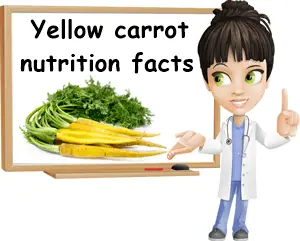Yellow carrots are one of the original carrot colors and long precede the orange carrot.
What makes yellow carrots yellow is a high content of pigmented antioxidants called xanthophylls. Yellow carrots are perfectly safe to eat and you can eat them both raw and cooked.
Their nutrition is fairly similar to that of the orange carrot, except for the fact that they have a much lower vitamin A content.
Nevertheless, yellow carrots are good for eyesight, and have blood pressure lowering benefits and anticancer properties.
What is a yellow carrot?
A yellow carrot is a variety of carrot with yellow flesh. Yellow carrots are one of the first carrot colors, preceding modern-day orange carrots by quite a few centuries. Despite concerns of being genetically modified, yellow carrots are not in fact GMO (genetically modified organisms). Believe it or not, yellow carrots occurred naturally early on into the domestication of the wild carrot, Daucus carota. The original color of carrots was white or cream, so it’s actually not that much of a stretch of imagination.
Find out more about yellow carrots.

What do yellow carrots look like?
Yellow carrots are a typical looking carrot: an elongated taproot tapering to a point or to a rounded tip. The taproot may be longer or shorter, more slender or broader, conical even, depending on the cultivar. Thin, hair-like secondary roots may sprout from the surface of the carrot. Yellow carrots are yellow both on the outside and the inside.
The exact color may range from a deep yellow to a pale yellow, almost cream color. However, bicolor varieties such as purple carrots with a yellow core also exist. The top part of the carrot may be light green which means that part of the vegetable has likely been exposed to sunlight during growing. Yellow carrot leaves look exactly like any other carrot leaves.
You might be interested: Are Baby Carrots Real?
Yellow Carrots vs Orange Carrots
What makes yellow carrots yellow is a high content of pigmented yellow antioxidants called xanthophylls. Vs orange carrots which owe their color to a high content of pigmented orange antioxidants known as carotenes.
Xanthophylls in yellow carrots are carotenoids, and so are carotenes in orange carrots. Yellow carrots are high in lutein and zeaxanthin pigments, versus orange carrots which are high in beta-carotene and alpha-carotene pigments.
What do yellow carrots taste like?
Yellow carrots do not taste that much different from orange carrots, except maybe a little sweeter, with a typical carrot flavor and odor. The taproot is hard, crunchy and crisp, and releases a pleasant carrot aroma when you bite into it.
If the carrot is too old, the taproot becomes woody. You can eat yellow carrots both raw and cooked and they are perfectly safe to eat. Cooked yellow carrots taste more delicate, and have a soft texture and a delicate, straightforward sweet taste.

Yellow carrot nutrition Values
Nutrition facts per 100 g:
- Energetic value: 41 kcal (kilocalories/calories)
- Carbohydrates content: 9.6 grams
- Fiber content: 2.8 grams
- Sugar: 4.7 grams
- Protein content: 0.9 grams
- Fat content: 0.25 grams
- Water content: 88.3 grams
Vitamins in yellow carrots:
- Vitamin A: low content (currently undetermined)
- Vitamin B1: 0.066 mg (milligrams)
- Vitamin B2: 0.058 mg
- Vitamin B3: 0.98 mg
- Vitamin B5: 0.273 mg
- Vitamin B6: 0.138 mg
- Vitamin B9: 19 mcg (micrograms)
- Vitamin B12: 0 mcg
- Choline: 8.8 mg
- Vitamin C: 5.9 mg
- Vitamin D: 0 mcg
- Vitamin E: 0.66 mg
- Vitamin K: 13 mcg
Minerals in yellow carrots:
- Calcium: 33 mg
- Copper: 0.045 mg
- Iron: 0.3 mg
- Magnesium: 12 mg
- Manganese: 0.143 mg
- Phosphorus: 35 mg
- Potassium: 320 mg
- Selenium: 0.1 mcg
- Sodium: 69 mg
- Zinc: 0.24 mg
Note: The following nutrition facts for yellow carrots are inferred from available information on the nutritional status of orange carrots and will be updated as new information comes in.
16 Yellow Carrot Benefits
- Yellow carrots contribute to the physical health of the eyes via antioxidants such as lutein and zeaxanthin which get absorbed in the retina and macula lutea area of the eyes.
Note: Lutein and zeaxanthin found in yellow carrots, and other foods, account for up to 80% of all carotenoids in the retina (source). - Benefits for color vision thanks to a good content of the xanthophyll antioxidant lutein.
- Benefits for age-related macular degeneration (AMD), halting progression to advanced forms and reducing risks (source).
- Lower risk of developing cataract thanks to the protective effects of lutein and zeaxanthin antioxidants (source 1, source 2).
Note: Cook and eat yellow carrots with a source of fat to help the body absorb lutein and zeaxanthin and deposit them in the retina. - Anticancer properties from the polyacetylenes falcarinol and falcarindiol found in yellow and other carrot colors which have an inhibitory effect on normal and cancer cell proliferation (source).
- Potential benefits for colon cancer prevention owed to polyacetylenes such as falcarinol which studies show reduces the number of (pre)cancerous lesions of the colon (source).
- Bioactive components in yellow carrots and other colors, parsnip, celery, fennel and parsley have scientifically proven cytotoxic effects against acute lymphoblastic leukemia (source).
- Anti-bleeding properties owed to a good content of vitamin K (11% of daily vitamin K requirements per 100 g of yellow carrots).
- Anti-inflammatory properties thanks to good amounts of vitamin K, vitamin C and bioactive antioxidants and other polyphenols.
- Minor blood pressure lowering benefits owed to a good potassium content and a low sodium content.
- Anti-anemia benefits owed to vitamins K, B1, B3, B6 and B9.
- Low-calorie food, good for healthy weight loss.
- Benefits for skin from vitamins B1, B2, B3, B5 and B6, C and E.
- Benefits for the nervous system owed to a range of B vitamins.
- Benefits for constipation owed to a good fiber content and profile.
- Minor benefits for diabetes-associated retinopathy (eye damage) and neuropathy (nerve damage). Find out more about carrots and diabetes.
Yellow carrot side effects
There aren’t really any side effects to eating yellow carrots, other than maybe carotenodermia or carotenosis which causes the skin to become temporarily discolored and turn slightly orange or yellow. The condition is caused by eating too many carrots which causes a buildup of the pigmented carotenoid antioxidants from the vegetable. Carotenodermia is both harmless and reversible and should clear by itself once consumption is discontinued.
